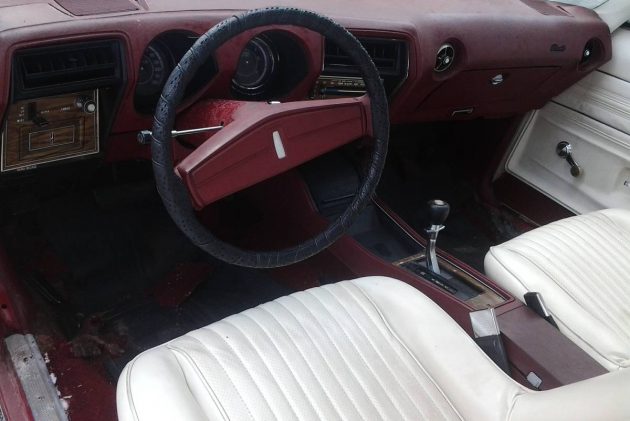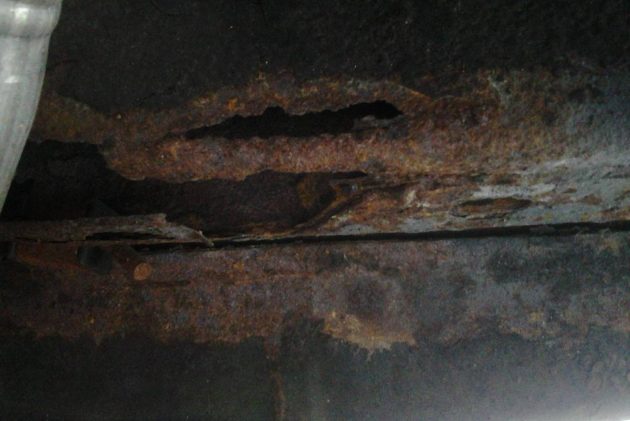One of the malaise-iest signifiers of the “Malaise Era,” which generally spans from the shock of the 1973 oil crisis to the early ’80s, is that many of the legendary nameplates of the ’60s and early ’70s didn’t die, but lingered as hollow imitations of what they had once been. An example is this Oldsmobile 4-4-2 from 1975, by which time the fabled badge had been reduced to an appearance and suspension package that could be applied to any Cutlass or Cutlass S coupe. This one appears to be an S, and, in keeping with the appearance package theme, wears clean cosmetics on top of a less-than-solid foundation. Reader Clarke B sent us the listing, on craigslist in Muskegon, Michigan, which has an asking price of $4,500.
When it debuted in 1964, the 4-4-2 moniker indicated that Olds’ hot new mid-sizer featured a four-barrel carburetor, a four-speed manual transmission, and a dual exhaust. By 1975, the only available manual transmission was a three-speed and it could only be paired with the newly introduced six-cylinder engine (a 4-4-2 first), and the arrival of catalytic converters spelled the end of functional dual exhausts. This nicely equipped, S-model 4-4-2 steps up to the 350-cubic inch Rocket V8, which was paired exclusively with a Turbo-Hydramatic; a 455 Rocket was also still available, but was similarly automatic-only. Note the swiveling front buckets for easy entry and exit through the Colonnade-body Cutlass’s massive, five-foot-long doors.
Unfortunately, under the cherry red paint and shiny white vinyl lurks rust, both in the floors and, more worryingly, in the frame. The car is, however, described as running and drivable, but more detail about its mechanical condition would be welcome. The Colonnade A-bodies are big, but were specifically designed to be good handlers, so with some rust remediation this could be a nice driver if all other systems are go—if not quite in the same vein as a 4-4-2 from a half-decade earlier.
If you’re handy with a blowtorch but don’t have $4,500 to drop, the seller notes that trades for “other buick chevy olds or pontiac 2 door car that interest me” [sic] will be entertained. Clearly an A- and G-body aficionado, the 4-4-2- is shown keeping company with several Regals, Monte Carlos, El Caminos, and other Cutlasses, which makes me wonder—what has this one marked for elimination from the herd?






The question of why sell this one, if I’m not mistaken most of the others in the picture are about 10+ years newer with the possible exception of what appears to be a 70 Monte Carlo – just a guess on my part.
With some rust repair, could be a fun car to take to the drive-in.
De smog it. You can do that even in California.
On most accounts, I’m a “small government” advocate but, the 1975 change to unleaded fuel was good for the country; the air quality has improved significantly since then. Car makers have overcome the engineering issues; they would have never voluntarily adopted unleaded fuel technology. In short, the catalytic converters should stay unless the car is set up for racing.
When fuel injection became available, cars started running better. Carbs were not able to maintain a constant fuel mix. Catalytic converters were not the problem.
By most accounts, it’s been stated the catalytic converter improved the drive-ability of these cars…I never quite understood why?
I had one almost just like that when I bought it it was just a year old the difference was mine was prepared with a white vynal top I had the converter cut and dual exhaust installed it was a good mover and what my wife noticed
Looks like this one might have dual exhaust looking at rear end shot if I only had the, money
Parts car. Even $1,000 might be too much.
Steve R
It makes me laugh when people take pictures of their car parked in weeds.
Yep, tells you all you need to know about how it was cared for and just how likely you are to find the rust problem is even worse than the pictures indicate.
I had a new 1974 442 with 455. After I put dual exhaust and took the smog stuff off it was decent. Will admit price is too far out there.
Cars from this era were choked by emissions equipment. It doesn’t take much to wake a car like this up. Exhaust, tuned carb, recurved distributor, and a gear.